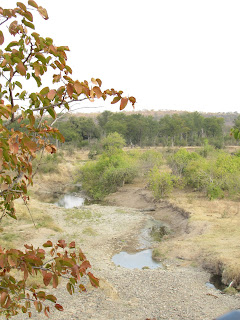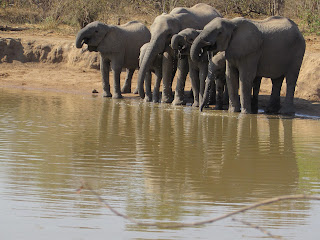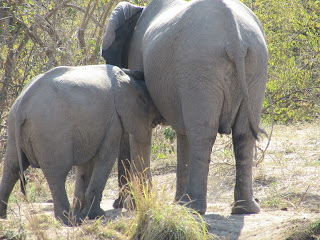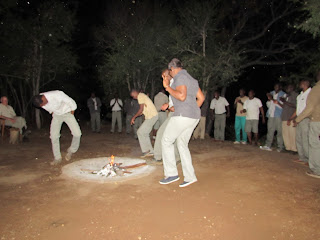We said our goodbyes at 8 am and headed the short distance to the air strip where our pilots were waiting for us.
One hour 20 minutes of flying and we arrived at Livingstone International Airport. We boarded our waiting bus and headed to the Zambia/Zimbabwe border. We stopped by for our first glimpse of the Zambezi River, the one that flows over Victoria Falls.
After going through the passport control, we drove to the historic bridge at the border and walked across. It's one lane traffic.
We then saw our first view of Victoria falls...just a small corner of it. We will have to wait a few days before we see the whole falls.
We went through Zimbabwe immigration and boarded a new bus and headed to Hwange.
The vendors at the border were selling Zimbabwe money....
Dan and Linda bought some and gave us 2 bills that total 6 billion dollars! Wow!! Thank you!!
Hyperinflation in Zimbabwe caused the collapse of the Zimbabwe currency, which is now worthless, except to the vendors which sell them to tourists for a few dollars. The US dollar is the currency used in Zimbabwe today....so I guess we are not billionaires after all.
Once in the town, Champion walked us through an open market and pointed out all sorts of things.
Cute kid...
Bags of polenta...an African staple.
And here's some of those dried sardines we had last night as an appetizer!
Champion showed us sandals for sale recycled from tires. They should never wear out!
We then stopped at OK...the grocery store chain. We will soon be visiting a village and will bring some food staples as a gift to the villagers. We all chipped in a few dollars and along with OATs contribution, Champion was able to fill a grocery cart.
We boarded our safari vehicles at the entrance to Hwange National Park. As we were driving along, a herd of elephants cross the road.
This one did not like that we were on the road and did a false charge before retreating.
We sat and watched the parade of elephants for a few minutes and then an oncoming vehicle alerted us to a leopard sighting just ahead. We carefully scanned the hillside and our guide spotted it.
We see another leopard! Leopard #4 Dan was able to capture these photos with his camera and zoom lens as it was a ways up the hill from us.
We were very lucky to have seen 4 different leopards on this trip. Some people never see one!
We arrived at the camp with the welcoming of the staff and settled into our tent.
The main hall for dining
Our tented cabin
Inside the tent
Bathroom with shower, sink and toiletThe next morning we take a break from game viewing to learn more about Zimbabwe's human residents in a village near the park.
Upon arrival at one family's compound, we were greeted by Shamal, who spoke good English. He is 24 years old and going to school to become a guide, he hopes for O.A.T.
The ladies helped each of us don our fabric chincinge skirts.
Shamal took us around the family compound and showed us the family's water spigot....water comes from the Zambezi River, maybe 60 km away. There were other water spigots alongside the road in the village where we saw women filling 5 gallon buckets and carrying them on their heads.
Shamal showed us the compound's shower....go fetch some water and heat it if you wish and then enter the shower stall and splash it on yourself and that's your shower.
Inside the shower...
We saw the silo crib where the corn and watermelons and squash are stored.
Next was the backup ambulance...a wagon that an ox would pull if someone needed to go to the hospital and the village's vehicle was broken down.
In the tree was a supply of rope, made from the trees.
We entered one hut..the sleeping quarters for a mother and daughter.
It contains a bed, a nightstand and a wardrobe. Each hut has a mosquito net treated with insecticide to guard against malaria.
Next was the kitchen where the women cook.
They have no ovens...everything is cooked in pots
We had bush tea and a cookie inside the kitchen brought by Champion from our camp.
We introduced each one of us and the ladies and children introduced themselves. We learned how the people live, tend to their animals and raise their crops. We were able to ask questions to gain an insight into their culture first-hand. And the ladies had questions for us.
Outside we watched a demonstration of how to grind the grain and we each had the opportunity to try it.
Lastly we gave the compound some groceries that both OAT and our group donated money to buy.
And we also purchased a goat, which is their bank account. They barter goods and services with goats. They will only eat a goat for a celebration of some sort.
Then it was back to the camp for lunch and rest until the afternoon's "Learning and Discovery" talk about polygamy.
Mofuka, one of our guides, practices polygamy. He has 3 wives, 10 children, 20 plus grandchildren and 10 great grandchildren. He explained how all his wives came about. His grandfather practiced polygamy, but his father did not. It was not something he thought about until Wife #1 brought up the idea of getting Wife #2; she wanted help around the house. He ended up with 2 more wives; but Wife #4 didn't fit in so they divorced....by the wife giving him 10 cents!
This all raised many, many questions from our group. Our heads were spinning...Mofuka answered them all very openly and said that the practice of polygamy is very common in the villages. Champion didn't always agree with what he said.
Then we went on a late afternoon game drive. Our guide, Abiot, and Champion saw lion tracks and we followed them toward the river. Abiot drew a circle around the lion paw print.
The trees were not very tall around here. We learned that the elephants beat the trees down as they feed and the trees keep leafing out. With the leaves being closer to the ground, the smaller animals like the kudos and impalas have an easier way to feed.
We came upon a herd of about 10 elephants going down to the river to drink and then eat at the trees. We watched them for quite awhile as the sun set. Never saw the lion, but we did keep a watchful eye out for it.
The next morning we leave for our last game drive of our trip...it will be an all-day drive as we go to the far end of the park beyond the reservoir.
We see the African hoopoe bird.
Then Mofuka stops and picks up a weaver bird nest that was on the ground due to elephants pushing down a tree. The nests have 2 holes for entrance/quick exit.
And this is a weaver bird we saw back at the camp.
This is what the nests look like hanging in the trees.
Tawny eagle.
Then we come to a hippo laying in the mud.
We watch him for awhile--he blinks his eyes and twitches his ears so we know he is alive.
and as we are watching a three-banded plover bird, which nests in the gravel alongside the road,
...we see the hippo walking out of the mud hole.
Our vehicle won't start and Mufuka has to tighten up the battery cables. We were right by the plover nest and the bird left it when Mufuka stepped out of the vehicle. The bird tried to fake a broken wing so we would follow it away from the nest. With it gone, we could see the eggs.
We carried on seeing Cape buffalo, warthogs, and giraffes....
And then we saw elephants....lots of them by a waterhole. We watched them for quite awhile as they grouped up and drank water, splashed water and mud on themselves and ate the foliage around the waterhole.
There were hippos keeping their eyes on us from the water.
Elephant stretching? on a stump or maybe just showing off!
There was a baby nursing and other young elephants rolling in the mud.
There had to have been 60-70 elephants in this area. They were fascinating to watch.
After we left the elephants, we stopped to investigate a hole an aardvark dug in a termite mound. It was not occupied so we never saw an aardvark.
Mufuka showed us the leaves of the evergreen tree...the giraffes can wrap their tongues around the branch and pull off the leaves and not the thorns.
On the next bush he showed us how the thorns lay down and the leaves can be pulled off. That bush also can send out toxins to the leaves when the animals have consumed too much of the plant.
We then stopped for tea and coffee at the reservoir. There was a huge elephant skull on display at this rest stop.
We saw several hyrax, which resemble rabbits or rodents. Our guide thinks it was a hyrax that the last leopard (#4) may have been hunting.
We drove on to where we had lunch at a big waterhole. Water is pumped here from the reservoir miles away to provide much needed water for a variety of animals.
While we ate, we watched hippos, warthogs, elephants, crocs, kudos, impala, and baboons. This is how I always visualized Africa.
Then it was a 1.5 hour ride back to camp. We just sat back and enjoyed our last safari ride seeing kudos, elephants, giraffes, Cape buffalo, etc.
Just before dinner our "Learning and Discovery" talk was given by Sally, one of the business managers of the camp, who shared with us her life as a single mom and getting her education.
And out came the worm-like things that Champion bought at the market the other day...
Champion said they were soaked in water and then fried. Yes, they did look bigger. Yum, give them a try he said...
And so we did...not too much of a taste, maybe salty, and very chewy.
After our tasting, Champion and our guides took handfuls of it to....enjoy? They love it.
After dinner we enjoyed the Farewell program by staff
and we did our skit again...a day in the life of an Ultimate Africa tourist.
Here we are riding in the safari vehicle, bouncing along, dodging branches, and taking photos of animals.
The next morning we said our goodbyes and headed to Victoria Falls. But first, we stop by an elementary school...
To continue reading, scroll up towards the top of this page and click in the right-hand column the entry entitled: Victoria Falls, Zimbabwe.



















































































I can't believe you saw a Weaver bird. Hahaha!
ReplyDelete